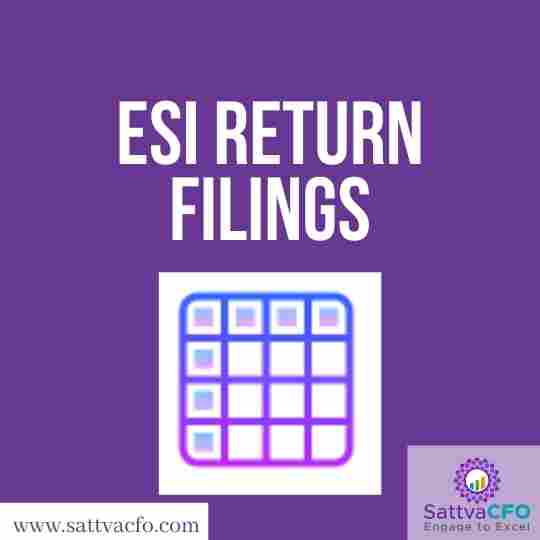Employees’ State Insurance (ESI) is self-supporting social security and health insurance plan for Indian workers, administered by the Ministry of Labour and Employment. Employee State Insurance Corporation (ESIC) and its laws and regulations govern this ESI Fund. All ESI-registered entities are required to file ESI returns, which are due every six months.
ESI Return Filing
Employers who are required to register under the Employee State Insurance Act of 1948 (“Act”) must take the following steps:
- All documentation must be kept on hand for future reference by an employer.
- After that, an employer must file Form 1, which is available on the ESIC website in PDF format. ESIC will check all of the information and assign a 17-digit unique number. All filings require this one-of-a-kind number.
- After the employer submits the paperwork with all of the necessary information, each employee will receive an ESI card. The following documents are necessary for registration:
- The company’s PAN card.
- Proof of business address
- The permit is issued under the Shop and Establishment Act or the Factories Act.
- Basic documents are necessary depending on the kind of institution – Articles of Association, Memorandum in the case of a corporation, partnership deed in the event of a partnership, and Limited Liability Partnership in the case of a limited liability partnership.
- All directors, partners, and stockholders are listed.
- All employees’ details, including their salaries.
- Information about the bank.
What is an ESI Return Filing?
Employees’ State Insurance (ESI) is self-supporting social security and health insurance plan for Indian workers, administered by the Ministry of Labour and Employment. Employee State Insurance Corporation (ESIC) and its laws and regulations govern this ESI Fund. All ESI-registered entities are required to file ESI returns, which are due every six months.
Applicability of ESI
The ESIC applies to all businesses with ten or more employees and is advantageous to all employees earning Rs.15, 000/- or less per month in salary. The employer must contribute 4.75 percent and the employee must contribute 1.75 percent to the ESIC.
How to file an ESIC return?
Employees who are enrolled with ESIC are entitled to medical care for themselves and their families and unemployment benefits and maternity leave for female employees.
Documents Required to File ESI return
The ESIC applies to all businesses with ten or more employees and is advantageous to all employees earning Rs.15, 000/- or less per month in salary. The employer must contribute 4.75 percent and the employee must contribute 1.75 percent to the ESIC.
- Employer Portal can be accessed by entering the 17-digit Employer digit code. When a firm registers under the ESI guidelines, they are given this code. When the company receives the 17-digit registration number, the ESI filing process can be completed quickly.
- Go to the area for monthly contributions. Before contemplating this, the employer or factory must ensure that all employee information is up to date before filing the returns.
- The employer contribution will be displayed on its whole.
- Check the specifics. After that, input your bank account information and proceed to submit your monthly employee return.
- If there are any outstanding payments owed to employees, make sure they are paid in full.
- Self-certification is done under the monthly contribution part, then the declaration is checked and the return is submitted.
FAQ’s
How can I file an ESI return?
- Contributions must be returned within 42 days following the end of the contribution period.
- Contributions must be paid within 21 days of the end of each calendar month.
- These returns must be filed every six months.
Is ESI half yearly return mandatory?
Employers must submit a half-yearly Return of Contributions (RC) by the 11th of May/11th of November each year, with all columns correctly filled.
Within 15 days of the ESI Act becoming relevant to a plant or business, an employer will file a Form-01 application for coverage under the Act.
When can we file ESIC Return?
The ESIC Return is filed on a half-yearly basis, which means it must be filed on or before the 11th of May and the 11th of November.
How can I check my ESIC status?
- The ESIC status can be checked by going to the ‘Portal Application ESIC’ website.
- The Employee Portal is shown in a window.
- To find out the status, the user must enter his ESIC insurance number, which is his IP number.
Can we withdraw the ESI amount?
- No, we cannot withdraw an ESI sum, but we can make use of the ESI benefits.
- The ESIC card can be used to access medical services.
- In India, there is no way to withdraw ESI money that has been contributed.
How can I check my ESIC paid Challan?
- Go to www.esic.in and select ESCI Challan Payment from the drop-down menu.
- Then input the Employer code and the captcha that appears.
- After then, the ESIC paid Challan can be examined.
Is ESI mandatory for employees?
- The ESI scheme is mandatory under the Act and applies to all factories and other establishments.
- When a business employs ten or more people and the recipients’ monthly salaries do not exceed Rs 21,000, they are eligible for this scheme.
Who are eligible for ESIC?
Employees with a monthly income of less than Rs. 21,000 per month (excluding overtime, bonuses, and leave encashment) are eligible for benefits under the Scheme.
Employees with daily average pay of up to Rs. 176, on the other hand, are exempt from ESIC contributions.
Can I claim an amount in ESI if I take treatment in private?
The Insured Persons are served by ESI’s Dispensaries and Hospitals.
As a result, ESIC policy discourages the use of outside treatment and reimbursement.
They allow for cashless treatment at outside private hospitals in certain circumstances and conditions that cannot be addressed under ESIC Infrastructure.
Is it mandatory for the Employer to register under the scheme?
Yes, under Section 2A of the Act, the employer is required to register their factory or establishment under the ESI Act within 15 days of the date of its applicability to them.
How can SattvaCFO support ESI Return filings in India?
Our ESI services can surely help you get through the cutthroat requirements of legal procedures. Though, we strictly follow the legal pathway; we ensure that your services are 100 percent taken care of. Our team at SattvaCFO, will guide you through the process and deal with all your burdens.




